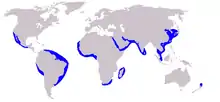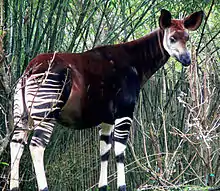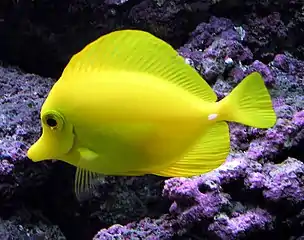Long-beaked common dolphin
The long-beaked common dolphin (Delphinus capensis) is a species of common dolphin. It has a more restricted range than the short-beaked common dolphin (D. delphis). It has a disjointed range in coastal areas in tropical and warmer temperate oceans. The range includes parts of western and southern Africa, much of western South America, central California to central Mexico, coastal Peru, areas around Japan, Korea and Taiwan, and possibly near Oman.[1][3] Vagrants have been recorded as far north as Vancouver Island. They live in shallow, warmer temperature waters near the coast. They also live in the tropical and subtropical regions.[4]
| Long-beaked common dolphin[1] | |
|---|---|
 | |
| Scientific classification | |
| Kingdom: | Animalia |
| Phylum: | Chordata |
| Class: | Mammalia |
| Order: | Artiodactyla |
| Infraorder: | Cetacea |
| Family: | Delphinidae |
| Genus: | Delphinus |
| Species: | D. capensis |
| Binomial name | |
| Delphinus capensis Gray, 1828 | |
| Subspecies | |
| |
 | |
| Range of long-beaked common dolphin | |
Physical characteristics
The long-beaked common dolphin is medium-sized, but smaller than the more popular bottlenose dolphin. Adults range between 1.9 and 2.5 m (6.2 and 8.2 ft), long, and can weigh between 80 and 235 kg (176 and 518 lb), although a range between 80 and 150 kg (180 and 330 lb) is more common.[5] Males are generally longer and heavier.[5] The color pattern on the body is unusual. The back is dark and the belly is white, while on each side is an hourglass pattern colored light grey, yellow or gold in front and dirty grey in back.[6] This species also has a rounded melon on tops of their heads used for echolocation.[4] It has a long, thin rostrum with up to 60 small, sharp, interlocking teeth on each side of each jaw.[7] They have more teeth than any other delphinids.[8]
Taxonomy
_(19772936113).jpg.webp)
The long-beaked common dolphin is a member of the common dolphin genus, Delphinus within the dolphin family, Delphinidae in the cetaceans order.[4] Until the mid-1990s, the different forms within Delphinus were not recognized as separate species, but were all considered members of the species D. delphis.[3][5] In 1994, Heyning and Perrin[9] did research on these species and then Kingston and Rosel[10] confirmed there were two separate species. Currently, the two recognized species of Delphinus are the short-beaked common dolphin (D. delphis) and the long-beaked common dolphin.[1] The long-beaked common dolphin is generally larger with a longer beak than the short-beaked common dolphin and has a longer rostrum.
The Indo-Pacific common dolphin is sometimes considered a separate species (D. tropicalis), but is more often considered a form of the long-beaked common dolphin.[1][3]
Behavior
.jpg.webp)
Long-beaked common dolphins can live in aggregations of hundreds or even thousands.[3] Within these large groups, smaller subgroups of 10 to 30, related in either sex or age, typically are found.[4] They sometimes associate with other dolphin species, such as pilot whales.[3] They have also been observed bow riding on baleen whales, and they also bow ride on boats.[3] Breaching behavior and aerial acrobatics are common with this species.[5]
Diet
The long-beaked common dolphin has a varied diet consisting of small schooling fish, such as sardines, anchovies, mackerels, pilchards, mullet, drum or croaker. These dolphins may occasionally eat small cephalopods such as octopuses and squid, and more rarely eat small crustaceans like large shrimp or small crab. Since they gather in huge superpods and there is seldom enough food in one place to support all of them, smaller groups leave the main pod for a few hours to feed.[11] They are able to dive in the water to about 900 feet (270 m) and hold their breath for up to 8 minutes to catch prey.[4]
Reproduction
The long-beaked common dolphin has a gestation period of 10 to 11 months typically during spring or autumn.[4][5] The newborn calf has a length of between 80 and 100 cm (2.6 and 3.3 ft) and a weight of about 10 kilograms (22 lb).[5] The young and juvenile dolphins coloration and patterns are darker than the adults.[11] Typical interbirth interval ranges from one to three years.[5] In captivity, this dolphin has hybridized with the common bottlenose dolphin (Tursiops truncatus).[3][12] One of the hybrids has been bred back to a bottlenose dolphin, demonstrating such hybrids are fertile.[12] The long-beaked common dolphin can live up to 40 years.[4]
Relationship to humans and other species
Long-beaked common dolphins are not common in human care as they are extremely difficult to keep in captivity. In the wild, however, they have been seen travelling with bottlenose dolphins, pilot whales, and yellowfin tuna.[13]
Conservation
Delphinus capensis is covered by the Memorandum of Understanding Concerning the Conservation of the Manatee and Small Cetaceans of Western Africa and Macaronesia[14] and the Memorandum of Understanding for the Conservation of Cetaceans and Their Habitats in the Pacific Islands Region (Pacific Cetaceans MoU).[15] One of the main threats to the long-beaked common dolphin is fisheries. Out of 930 dolphins observed off of Peru between 1985 and 2000, 120 of them had many lacerations on their head, skin, appendages, and teeth. Most of these injuries were from fisheries-related connection.[16] Another threat to this species is pollution because many of them have shown signs of organochlorine residue on their blubber.[17] On the coast of California there are only about 25,000 to 43,000 dolphins and on the coast of South Africa there are 15,000 to 20,000.[5]
See also
 Cetaceans portal
Cetaceans portal Mammals portal
Mammals portal Marine life portal
Marine life portal- List of cetaceans
- Marine biology
References
- Mead, J.G.; Brownell, R. L. Jr. (2005). "Order Cetacea". In Wilson, D.E.; Reeder, D.M (eds.). Mammal Species of the World: A Taxonomic and Geographic Reference (3rd ed.). Johns Hopkins University Press. pp. 723–743. ISBN 978-0-8018-8221-0. OCLC 62265494.
- Hammond, P.S.; Bearzi, G.; Bjørge, A.; Forney, K.; Karczmarski, L.; Kasuya, T.; Perrin, W.F.; Scott, M.D.; Wang, J.Y.; Wells, R.S.; et al. (2008). "Delphinus capensis". IUCN Red List of Threatened Species. 2008: e.T6337A12663800. doi:10.2305/IUCN.UK.2008.RLTS.T6337A12663800.en.
- Perrin, W. (2002). "Common Dolphins". In Perrin, W.; Wursig, B.; Thewissen, J. (eds.). Encyclopedia of Marine Mammals. Academic Press. pp. 245–248. ISBN 978-0-12-551340-1.
- Mark McGinley; Eileen Mary Dee (December 2011). "Long-beaked common dolphin". Encyclopedia of earth. Retrieved 1 April 2013.
- Shirihai, H. & Jarrett, B. (2006). Whales, Dolphins and Other Marine Mammals of the World. pp. 174–176. ISBN 978-0-691-12757-6.
- Reeves; Stewart; Clapham; Powell (2002). Guide to Marine Mammals of the World. p. 388. ISBN 978-0-375-41141-0.
- "The Common Dolphin". Archived from the original on 2008-06-19. Retrieved 2008-07-03.
- Jefferson, Thomas A.; Webber, Marc A.; Pitman, Robert L. (2011). Marine Mammals of the World: A Comprehensive Guide to Their Identification. Elsevier. p. 249. ISBN 978-0-08-055784-7.
- Heyning JE, Perrin W F (1994) Evidence for two species of common dolphins (genus Delphinus) from the eastern North Pacific. Los Angeles County Mus. Nat. Hist. Contr. Sci. 442: 1–35.
- Kingston SE, Rosel PE (2004). "Genetic differentiation among recently diverged delphinid taxa determined using AFLP markers" (PDF). The Journal of Heredity. 95 (1): 1–10. doi:10.1093/jhered/esh010. PMID 14757724.
- "Long-Beaked Common Dolphin (Delphinus capensis)". NOAA Fisheries, Office of Protected Resources. 2012. Retrieved 1 April 2013.
- Zornetzer H.R.; Duffield D.A. (October 1, 2003). "Captive-born bottlenose dolphin × common dolphin (Tursiops truncatus × Delphinus capensis) intergeneric hybrids". Canadian Journal of Zoology. NRC Research Press. 81 (10): 1755–1762. doi:10.1139/z03-150.
- Museum of Natural History, New York City, NY
- Memorandum of Understanding Concerning the Conservation of the Manatee and Small Cetaceans of Western Africa and Macaronesia. Convention on Migratory Species. Cms.int (2008-10-03). Retrieved on 2014-01-04.
- Memorandum of Understanding for the Conservation of Cetaceans and Their Habitats in the Pacific Islands Region. Pacificcetaceans.org. Retrieved on 2014-01-04.
- Van Bressem M-F; Van Waerebeek K; Montes D; Kennedy S; Reyes JC; Garcia-Godos IA; Onton-Silva K; Alfaro-Shigueto Joanna (2006). "Diseases, lesions and malformations in the long-beaked common dolphin Delphinus capensis from the Southeast Pacific". Diseases of Aquatic Organisms. 68 (2): 149–65. doi:10.3354/dao068149. PMID 16532606.
- Kajiwara N, Matsuoka S, Iwata H, Tanabe S, Rosas FC, Fillmann G, Readman JW (2004). "Contamination by persistent organochlorines in cetaceans incidentally caught along Brazilian coastal waters". Archives of Environmental Contamination and Toxicology. 46 (1): 124–34. doi:10.1007/s00244-003-2239-y. PMID 15025172.
